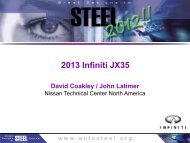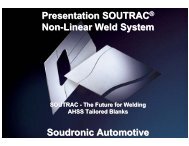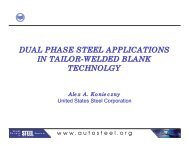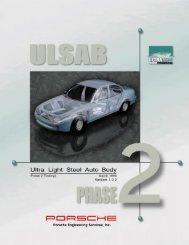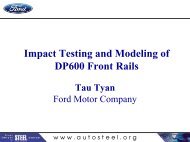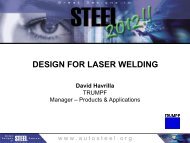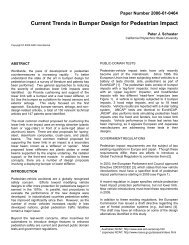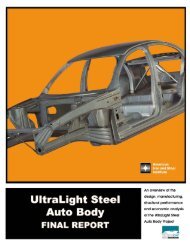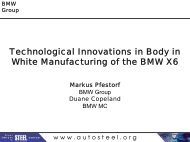50 year Perspective of Automotive Engineering Body Materials
50 year Perspective of Automotive Engineering Body Materials
50 year Perspective of Automotive Engineering Body Materials
Create successful ePaper yourself
Turn your PDF publications into a flip-book with our unique Google optimized e-Paper software.
<strong>50</strong> <strong>year</strong> <strong>Perspective</strong> <strong>of</strong> <strong>Automotive</strong><br />
<strong>Engineering</strong> <strong>Body</strong> <strong>Materials</strong> and an<br />
Analysis <strong>of</strong> the Future<br />
Jody N. Hall<br />
Manager, Global Die Standards & <strong>Materials</strong> Applications<br />
General Motors Manufacturing <strong>Engineering</strong><br />
Great Designs in Steel 2008<br />
1
Steel Becomes the “Material Material <strong>of</strong> Choice” Choice<br />
for Auto Bodies<br />
Benz Patent Motorwagen 1886 (Replica)<br />
• 1914 Dodge & Budd produce<br />
5,000 all-steel bodies<br />
• All-steel body was lighter,<br />
stronger, easier to make<br />
• Most significant advantage was<br />
in painting<br />
• Original bodies made <strong>of</strong> wood<br />
& steel<br />
• Quick to tool, easy to change<br />
• Large number <strong>of</strong> skilled<br />
workers<br />
Dodge Brothers Touring Car 1917<br />
2
“Every Every time the price <strong>of</strong> steel goes up,<br />
Detroit’s Detroit s auto makers moan in anguish<br />
and intensify their search for<br />
replacements”<br />
replacements<br />
3
gas<br />
“Every Every time the price <strong>of</strong> steel goes up,<br />
Detroit’s Detroit s auto makers moan in anguish<br />
and intensify their search for<br />
replacements”<br />
replacements<br />
4
<strong>Materials</strong> Causing the Biggest Stir in <strong>Body</strong><br />
Technology<br />
Plastics<br />
-“been been getting the big play …<br />
as successor to steel” steel<br />
Aluminum Alloys<br />
-“about about as strong as steel,<br />
less than half the weight” weight<br />
-“used used …since since birth <strong>of</strong> auto” auto<br />
-“most most plentiful metal on earth” earth<br />
Magnesium Alloys<br />
-“even even lighter than aluminum,<br />
stronger for its weight than steel” steel<br />
-“most most easily machined and cast” cast<br />
-“enough enough in the ocean… ocean<br />
to provide 100,000,000 tons a <strong>year</strong>”<br />
<strong>year</strong><br />
5
Published October 1953<br />
“The day <strong>of</strong> the passenger<br />
car made primarily <strong>of</strong> iron<br />
and steel is on the wane!<br />
Some sources predict that<br />
by 1960 a Cadillac will weigh<br />
less than a 1953 Chevrolet<br />
and a Chevy will probably<br />
weigh about as much as a<br />
motorcycle.”<br />
6
Prediction <strong>50</strong>+ Years Ago… Ago<br />
PAST<br />
Steel<br />
Mg<br />
Al Plastics<br />
FUTURE<br />
7
Key Product Drivers & Resulting Vehicles<br />
Safety<br />
Focus<br />
Oil<br />
Shock<br />
Global<br />
Competition<br />
Customer<br />
Personalization<br />
19<strong>50</strong> 1960 1970 1980<br />
1990 2000+<br />
1997 2006 – Audi – The introduces C6 Z06<br />
the first<br />
Pontiac releases<br />
Late<br />
all aluminum Corvette volume is volume is released.<br />
Late 1970’s 1970 – Dodge releases<br />
released. production<br />
1953 – Chevrolet Introduces the<br />
car. The Aluminum frames<br />
Corvette<br />
Charger<br />
Utilizes carbon fiber Corvette<br />
Charger w/ fiberglass<br />
XL<br />
fiberglass<br />
XL that body.<br />
applies<br />
body.<br />
applies higher<br />
fiber<br />
weigh up to less than 40% <strong>of</strong><br />
Lightweight strength<br />
fenders, wheel houses,<br />
strength<br />
houses,<br />
body steel improves and all<br />
aluminum<br />
steel floors, frames and <strong>of</strong> comparable<br />
an aluminum<br />
aspects <strong>of</strong> components performance.<br />
that resulted in a<br />
design.<br />
285kg<br />
frame.<br />
285kg reduction in vehicle mass.<br />
frame.<br />
1984 – Pontiac releases<br />
the Fiero. Small, fuel<br />
efficient sports car that<br />
uses composite panels<br />
to reduce overall weight.<br />
Clean Air Act<br />
Highway Safety Act<br />
8
Mass Reduction<br />
Opportunity<br />
0%<br />
10%<br />
20%<br />
30%<br />
40%<br />
<strong>50</strong>%<br />
MILD STEELS<br />
Steel Mass Reduction<br />
CONV HSS<br />
1970 1980 1990 2000 2010 2020 2030<br />
Time<br />
9
Current <strong>Body</strong> and Closure Metallic Material<br />
Content by Type for North America<br />
Conventional<br />
HSS<br />
Medium<br />
HSS<br />
15.8%<br />
Advanced<br />
HSS<br />
12.7%<br />
Bake<br />
Hardenable<br />
Steel<br />
6.6%<br />
9.5%<br />
Aluminum &<br />
Magnesium<br />
0.8%<br />
Source: Ducker Worldwide<br />
2007<br />
Mild Steel<br />
54.6%<br />
8<strong>50</strong> Pounds<br />
10
The Question is …<br />
Why do these materials continue to fall<br />
short <strong>of</strong> the prediction?<br />
11
Comparison <strong>of</strong> <strong>Materials</strong> by Performance<br />
Mild Steel<br />
Density Modulus Tensile<br />
Strength<br />
----------BASELINE - - --------<br />
Elongation Corrosion<br />
Resistance<br />
Aluminum + - 0 0 0 / +<br />
Magnesium + - - 0 - 0 / -<br />
Polymers & + 0 / - - / 0 / + - +<br />
Composites<br />
KEY: 0 = equal + = better - = worse<br />
12
Steel<br />
Advantages:<br />
Comparison <strong>of</strong> <strong>Materials</strong> by Manufacturability<br />
• Formability<br />
• Weldability<br />
• Infrastructure<br />
• Painted Surface<br />
Disadvantages:<br />
• Castability<br />
Aluminum<br />
Advantages:<br />
• Formability<br />
• Castability<br />
• Painted Surface<br />
Disadvantages:<br />
• Lower<br />
formability than<br />
steel<br />
• Weldability<br />
Magnesium<br />
Advantages:<br />
• Castability<br />
Disadvantages:<br />
• Formability<br />
• Elevated<br />
temperature<br />
stamping &<br />
hemming<br />
• Weldability<br />
Polymer/<br />
Composites<br />
Advantages:<br />
• Low cost<br />
tooling<br />
• Shorter lead<br />
time<br />
Disadvantages:<br />
• Cycle Time<br />
• Infrastructure<br />
• Difficult to<br />
repair<br />
• Painted<br />
Surface<br />
13
Mild Steel<br />
(Baseline)<br />
Aluminum<br />
(Al)<br />
Magnesium<br />
(Mg)<br />
Comparison <strong>of</strong> <strong>Materials</strong> by<br />
Other Important Characteristics<br />
Cost<br />
(Est. $/lb.)<br />
PMC $1.20 -<br />
6.<strong>50</strong><br />
Availability<br />
(Annual Metric Ton<br />
Production)<br />
$0.<strong>50</strong> 110 Million<br />
Environment<br />
(Primary Production Emissions<br />
reported by industry)<br />
• easy to recycle<br />
• Emissions = 2.3 – 2.7 kg CO 2/kg /kg<br />
$1.00 2.5 Million • easy to recycle<br />
• Emissions = 13.9 – 15.5 kg<br />
CO 2/kg /kg<br />
$1.<strong>50</strong> 0.5 Million • easy to recycle<br />
• Emissions = 18.0 – 24.8 kg<br />
CO 2/kg /kg<br />
Unknown<br />
• difficult to recycle<br />
• Emissions = 2.5 – 23.0 kg CO 2/kg /kg<br />
14
Current <strong>Body</strong> and Closure Metallic Material<br />
Content by Type for North America<br />
Conventional<br />
HSS<br />
Medium<br />
HSS<br />
12.7%<br />
15.8%<br />
Bake<br />
Hardenable<br />
Steel<br />
Advanced<br />
HSS<br />
6.6%<br />
9.5%<br />
Aluminum &<br />
Magnesium<br />
0.8%<br />
Source: Ducker Worldwide<br />
2007<br />
54.6%<br />
Mild Steel<br />
8<strong>50</strong> Pounds<br />
15
Comparison <strong>of</strong> <strong>Materials</strong> by Performance<br />
Mild Steel<br />
Density Modulus Tensile<br />
Strength<br />
----------BASELINE - - --------<br />
Elongation Corrosion<br />
Resistance<br />
Aluminum + - 0 0 0 / +<br />
Magnesium + - - 0 - 0 / -<br />
Polymers & + 0 / - - / 0 / + - +<br />
Composites<br />
HSS/AHSS 0 0 + + 0 / - 0<br />
16
Comparison <strong>of</strong> <strong>Materials</strong> by Manufacturability<br />
Steel &<br />
HSS/AHSS<br />
Advantages:<br />
Advantages<br />
• Formability<br />
• Weldability<br />
• Infrastructure<br />
• Painted Surface<br />
Disadvantages:<br />
Disadvantages<br />
• Castability<br />
Aluminum<br />
Advantages:<br />
Advantages<br />
• Formability<br />
• Castability<br />
• Painted Surface<br />
Disadvantages:<br />
Disadvantages<br />
• Lower<br />
formability than<br />
steel<br />
• Weldability<br />
Magnesium<br />
Advantages:<br />
Advantages<br />
• Castability<br />
Disadvantages:<br />
Disadvantages<br />
• Formability<br />
• Elevated<br />
temperature<br />
stamping &<br />
hemming<br />
• Weldability<br />
Polymer/<br />
Composites<br />
Advantages:<br />
Advantages<br />
• Low cost<br />
tooling<br />
• Shorter lead<br />
time<br />
Disadvantages:<br />
Disadvantages<br />
• Cycle Time<br />
• Infrastructure<br />
• Difficult to<br />
repair<br />
• Painted<br />
Surface<br />
17
Mild Steel<br />
(Baseline)<br />
Aluminum<br />
(Al)<br />
Magnesium<br />
(Mg)<br />
Comparison <strong>of</strong> <strong>Materials</strong> by<br />
Other Important Characteristics<br />
Cost<br />
(Est. $/lb.)<br />
PMC $1.20 -<br />
6.<strong>50</strong><br />
Availability<br />
(Annual Metric Ton<br />
Production)<br />
$0.<strong>50</strong> 110 Million<br />
Environment<br />
(Primary Production Emissions<br />
reported by industry)<br />
• easy to recycle<br />
• Emissions = 2.3 – 2.7 kg CO 2/kg /kg<br />
$1.00 2.5 Million • easy to recycle<br />
• Emissions = 13.9 – 15.5 kg<br />
CO 2/kg /kg<br />
$1.<strong>50</strong> 0.5 Million • easy to recycle<br />
• Emissions = 18.0 – 24.8 kg<br />
CO 2/kg /kg<br />
Unknown<br />
HSS/AHSS $0.55 Included in Mild<br />
Steel<br />
• difficult to recycle<br />
• Emissions = 2.5 – 23.0 kg CO 2/kg /kg<br />
• easy to recycle<br />
• Emissions = 2.3 – 2.7 kg CO 2/kg /kg<br />
18
Elongation (%)<br />
70<br />
60<br />
<strong>50</strong><br />
40<br />
30<br />
20<br />
10<br />
0<br />
IF<br />
Mild<br />
Steel Strategy<br />
Second Generation AHSS<br />
IF- HS<br />
ISO<br />
ISO<br />
BH<br />
CMn<br />
Conventional HSS<br />
TRIP<br />
HSLA<br />
DP, CP<br />
L-IP<br />
AUST. SS<br />
MART<br />
TWIP<br />
First Generation AHSS<br />
0 300 600 900 1200 1600<br />
Tensile Strength (MPa)<br />
19
Elongation (%)<br />
70<br />
60<br />
<strong>50</strong><br />
40<br />
30<br />
20<br />
10<br />
0<br />
IF<br />
Mild<br />
Steel Strategy - GAP<br />
IF-HS -<br />
BH<br />
ISO<br />
CMn<br />
TRIP<br />
HSLA<br />
DP, CP<br />
L-IP<br />
Future Future Opportunity Opportunity<br />
Third Third Generation Generation AHSS<br />
AHSS<br />
AUST. SS<br />
MART<br />
TWIP<br />
0 300 600 900 1200 1600<br />
Tensile Strength (MPa)<br />
20
What’s What s the same?<br />
• Other than prediction <strong>of</strong> lightweight material<br />
usage and the elimination <strong>of</strong> steel (by some)<br />
• Relative amongst materials:<br />
–Cost<br />
– Performance<br />
– Manufacturability<br />
– Availability<br />
• Fuel Cost<br />
• Strategy for material implementation<br />
21
<strong>Materials</strong><br />
<strong>Engineering</strong> Strategy<br />
Manufacturing<br />
Design<br />
22
Manufacturability<br />
& Cost:<br />
• material<br />
• design<br />
• manufacturing<br />
Business Strategy<br />
Government Regulations<br />
• Fuel Economy<br />
• Crash Performance<br />
• Emissions<br />
& Customer Requirements<br />
• Cost<br />
• Quality/Styling<br />
• Features<br />
23
Mass Reduction<br />
Opportunity<br />
0%<br />
10%<br />
20%<br />
30%<br />
40%<br />
<strong>50</strong>%<br />
Steel Mass Reduction Opportunities<br />
MILD STEELS<br />
CONV HSS<br />
With Steel Strategy<br />
& DOE Support<br />
FreedomCAR GOAL<br />
Technology<br />
Decision<br />
1970 1980 1990 2000 2010 2020 2030<br />
Time<br />
Without DOE<br />
Support<br />
AHSS<br />
MASS<br />
COMPOUNDING<br />
3rd GENERATION<br />
24
Global Market<br />
North America Europe<br />
Well developed market Well developed market<br />
Consumer demand for large<br />
vehicles Latin America, Africa Consumer & Asia Middle Pacific demand East for a balance <strong>of</strong><br />
utility<br />
Relatively Diverse low market fuel prices<br />
Fast<br />
& efficiency<br />
growing diverse market<br />
Primary New<br />
challenges <br />
market players<br />
U.S. Relatively CAFE Infrastructure high fuel prices still developing<br />
and emissions regulations<br />
(particularly Lead in alternative Taxes Primary<br />
diesel); strict fuels, on poor<br />
challenges<br />
fuel economy<br />
are<br />
&<br />
new fuel<br />
collision particularly performance ethanol emissions<br />
economy/emission regulations<br />
requirements Primary challenge Primary is product challenges CO2 commitment<br />
cost<br />
and Euro 5 emissions; strict collision<br />
performance requirements<br />
Opportunity for more growth<br />
25
Vehicles per Thousand People<br />
800<br />
600<br />
400<br />
200<br />
Global Transportation Growth<br />
Africa<br />
China<br />
Source: Joe Carpenter, DOE<br />
Eastern Europe<br />
Mid-East<br />
Former Soviet Union<br />
Latin America<br />
Developing Asia<br />
Industrialized Pacific<br />
Western Europe<br />
U.S. Historic<br />
0<br />
1900 1910 1920 1930 1940 19<strong>50</strong> 1960 1970 1980 1990<br />
China, with 13 vehicles per 1000 people, is where the U.S. was in 1913<br />
China’s population is currently 4 times the population <strong>of</strong> the U.S.<br />
U.S.<br />
26
What materials will be used<br />
to meet these demands?<br />
27
Con.<br />
HSS<br />
15.8%<br />
Medium<br />
HSS<br />
NORTH AMERICAN<br />
LIGHT VEHICLE METALLIC MATERIAL TRENDS<br />
Advanced<br />
HSS<br />
9.5%<br />
12.7%<br />
<strong>Body</strong> and Closure Metallic Material Content by Type<br />
6.6%<br />
Bake Hardenable<br />
2007 2015<br />
Aluminum &<br />
Magnesium<br />
0.8%<br />
8<strong>50</strong> Pounds<br />
Source: Ducker Worldwide<br />
54.6%<br />
Mild Steel<br />
Advanced<br />
HSS<br />
34.8%<br />
10.2%<br />
Conventional<br />
HSS<br />
Aluminum &<br />
Magnesium<br />
2.5%<br />
800 Pounds with an Equal<br />
Footprint to 2007<br />
Mild Steel<br />
29.0%<br />
23.5%<br />
Bake Hardenable and<br />
Medium HSS<br />
28
NORTH AMERICAN<br />
LIGHT VEHICLE METALLIC MATERIAL TRENDS<br />
North American Light Vehicle Material Content Per in Pounds<br />
1975 2005 2007 2015<br />
Change From<br />
1975 to 2015<br />
Mild Steel 2,180 1,751 1,748 1,314 Down 866 lbs.<br />
High Strength Steel 140 324 334 315 Up 175 lbs.<br />
Advanced HSS -- 111 149 403 Up 403 lbs.<br />
Other Steels 65 76 76 77 Up 12 lbs.<br />
Iron 585 290 284 244 Down 341 lbs.<br />
Aluminum 84 307 327 374 Up 290 lbs.<br />
Magnesium -- 9 9 22 Up 22 lbs.<br />
Other Metals 120 1<strong>50</strong> 149 145 Up 25 lbs.<br />
Plastic/Composites 180 335 340 364 Up 184 lbs.<br />
Other <strong>Materials</strong> 546 629 634 6<strong>50</strong> Up 104 lbs.<br />
Total Pounds 3,900 3,982 4,0<strong>50</strong> 3,908* Up 8 lbs.<br />
Source: Ducker Worldwide<br />
* Same vehicle mix and average footprint as 2007<br />
29
Advanced<br />
HSS<br />
34.8%<br />
NORTH AMERICAN<br />
LIGHT VEHICLE METALLIC MATERIAL TRENDS<br />
<strong>Body</strong> and Closure Metallic Material Content by Type<br />
North America<br />
10.2%<br />
Conventional<br />
HSS<br />
Aluminum &<br />
Magnesium<br />
2.5%<br />
Mild Steel<br />
29.0%<br />
23.5%<br />
Bake Hardenable and<br />
Medium HSS<br />
2015<br />
PHS, TWIP<br />
& Others<br />
12.0%<br />
30.0%<br />
AHSS<br />
Europe<br />
Aluminum &<br />
Magnesium<br />
3.0%<br />
Mild Steel & BH<br />
25.0%<br />
30.0%<br />
Conventional HSS<br />
30
Why is this reasonable?<br />
• No real changes in basic trends over past <strong>50</strong><br />
<strong>year</strong>s<br />
• “Cash is King” – customer paying less than<br />
before & demanding more<br />
• Infrastructure not ready<br />
• Availability – Infrastructure <strong>of</strong> metal<br />
production<br />
• Global Differences in Needs<br />
31
What could ‘disrupt disrupt’ this prediction<br />
• Fuel Cost & Availability<br />
• Material Cost & Availability<br />
• Economic Stability<br />
• Government Regulations<br />
• Technological Discoveries/Advances<br />
32
Conclusions<br />
• Always be a need/desire to push to<br />
lightweight materials for the auto industry<br />
• Doesn’t mean no steel<br />
• Current prediction is mainly some form <strong>of</strong><br />
steel<br />
– Best value to customer (performance/cost)<br />
• However, disruptive event(s) is as likely, or<br />
even more likely, than ever before<br />
33



